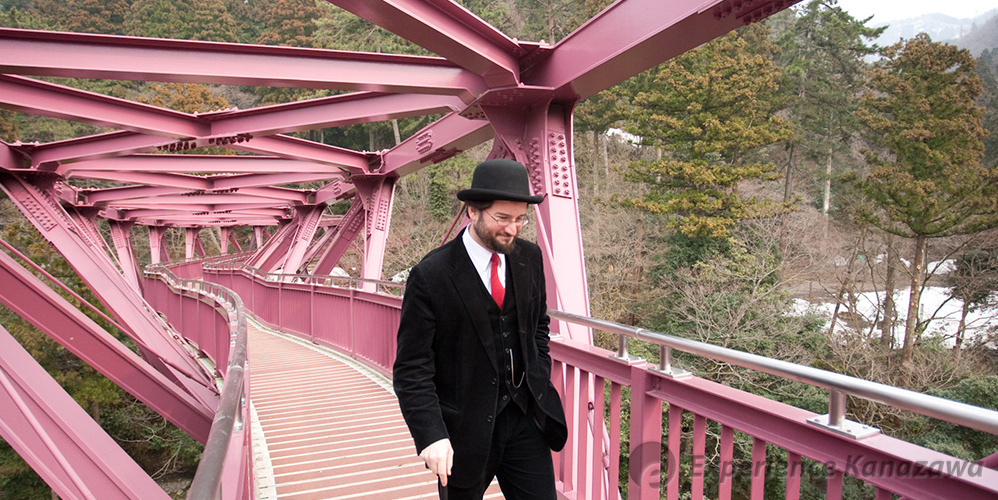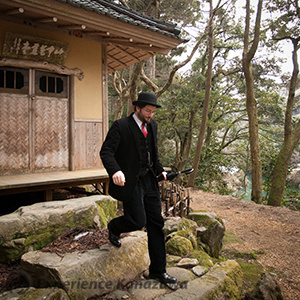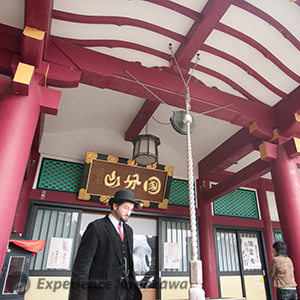Following Matsuo Bashô’s steps in Ishikawa


Bashô in Yamanaka-Onsen
The very name of Yamanaka Onsen sounds as a promise to experience sheer and peaceful delights. Straggling along the gracious gorges of Kakusenkei, this old and very typical hot spring town takes advantage of its remarkable natural setting. The gentle flows of the Daishoji River, the cheerful songs of numerous bird species create a tranquil and soothing murmur that enhances the visitor’s stay.
Leaving behind the indeterminate feelings he had around Komatsu, resolutely heading to the southern areas of western Japan, Matsuo Bashô is believed to have stayed there, resting from his fatigue, for no less than eight days, between September and October. There too, our itinerant poet seems to have followed the paths of illustrious travellers who preceded him. The town’s long history recalls the first of them, an itinerant monk named Gyôki who lived in the first half of the 8th century. Travelling north from Nara, he is said to have discovered the local hot springs, thanks to several apparitions of the healing Buddha.
The town is actually one of Japan’s three main places where the healing Buddha is worshiped, along with temples in Kyoto and Izumo. Located on the slope of the neighbouring mountain, not far from Kiku-no-yu, the town’s traditional public bath, the Kokubunzan Ioji Temple, founded in the 8th century by Gyôki, has a striking vermillion pagoda.
It also enshrines several precious assets, displaying the town’s tradition for skilful crafts such as the Kutani Porcelain and the local Yamanaka lacquer-ware.Bashô stopped there too, leaving a walking stick proudly exhibited here, and a witty haiku that everyone around in Yamanaka knows by heart.
At Yamanaka
No need to pick chrysanthemums
The scent of hot springs
“To leave a happy life, one should grow chrysanthemums” says an old Chinese proverb. The physicians of China and Japan knew quite well of its therapeutic benefits for the body and soul. The chrysanthemum is queen of all flowering species of Japan, symbolizing values of peace, nobility, long wealthy life, and evenly the emblem of the imperial family. Bashô must have enjoyed an absolute experience of relaxing in Yamanaka’s hot spring to dare put down on a paper such words of lese majesty. Later on, in a work entitled Hot Springs, he would introduce Yamanaka Onsen, along Arima and Kusatsu, as the most renowned of the many hot springs of Japan.


Bashô especially loved the Kakusenkei promenade site, a little path along the banks of the Daishoji River, through a harmonious natural setting filled with scattered strangely shaped rocks and gracious waterfalls. Walking downstream from the exquisite Koorogi bridge, exclusively constructed in Japanese cypress, leads first to the Ayatori Bridge, a modern curve shaped iron construction, designed by the renowned ikebana artist and movie director Hiroshi Teshigahara. Further on is the Kurotani Bridge, whose style brings us back to the Taishô era, at the beginning of the twentieth century when the city of Yamanaka was in full renaissance. Beyond sprawls the coastal valley, heading south to the feudal town of Daishoji. Yet is another leg to come and time to leave for Matsuo Bashô.
Considered as one of four great sages of Yamanaka, the figure of Matsuo Bashô is still greatly revered among the locals. Besides an elegant museum located in the centre of the town, a traditional style hut was built in honour of the visitor, a little upstream from Kurotani Bridge. At every season the scenery is splendid. Tea ceremonies or haiku meetings held here celebrate the precious words he bestowed on the town of Yamanaka Onsen.
Kanazawa Area
Kenrokuenn Garden
Following Matsuo Bashô’s steps in Ishikawa - 1/6 [Introduction]
Following Matsuo Bashô’s steps in Ishikawa - 2/6 [Kanazawa]
Noto Area
Mitsukejima Island
Kaga Area
Following Matsuo Bashô’s steps in Ishikawa - 3/6 [Komatsu City]
Following Matsuo Bashô’s steps in Ishikawa - 4/6 [Natadera Temple]
Following Matsuo Bashô’s steps in Ishikawa - 5/6 [Yamanaka Onsen Town]
Following Matsuo Bashô’s steps in Ishikawa - 6/6 [Daishoji District]
Rosanjin in Yamashiro Onsen Town
Stroll Kanazawa in Rental Kimono - 1/2 [Kimono Rental]
Stroll Kanazawa in Rental Kimono - 2/2 [Kimono Stroll]
January
Enyukai: Geisha Party
February
Setsubun-Sai Festival
AUGUST
Issaki Hoh-Toh Matsuri
November
Enyukai: Geisha Party

